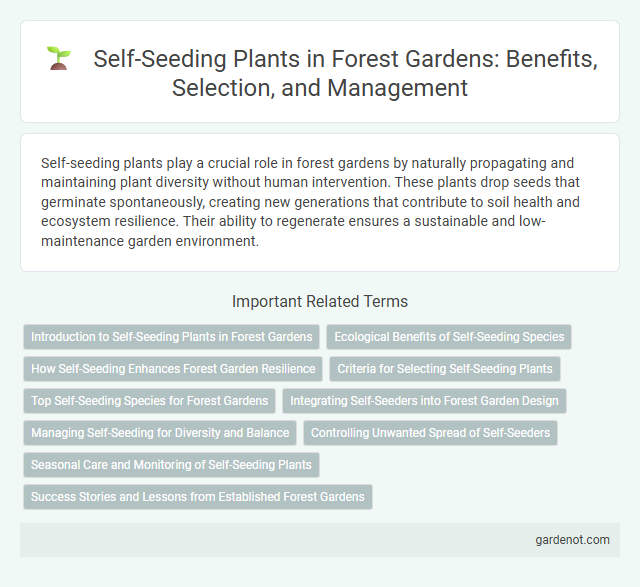Self-seeding plants play a crucial role in forest gardens by naturally propagating and maintaining plant diversity without human intervention. These plants drop seeds that germinate spontaneously, creating new generations that contribute to soil health and ecosystem resilience. Their ability to regenerate ensures a sustainable and low-maintenance garden environment.
Introduction to Self-Seeding Plants in Forest Gardens
Self-seeding plants in forest gardens play a vital role in natural regeneration by dispersing seeds that germinate without human intervention, enhancing biodiversity and resilience. Species such as comfrey, chicory, and evening primrose are popular choices due to their ability to establish quickly and support soil health through nutrient accumulation. Integrating these self-replenishing plants reduces maintenance, fosters a dynamic ecosystem, and promotes sustainable forest garden management.
Ecological Benefits of Self-Seeding Species
Self-seeding plants in forest gardens enhance biodiversity by naturally propagating without human intervention, creating resilient ecosystems that support diverse wildlife. These species improve soil health through continuous ground cover, reducing erosion and promoting nutrient cycling. Their adaptive growth patterns foster habitat complexity, contributing to ecological stability and long-term sustainability.
How Self-Seeding Enhances Forest Garden Resilience
Self-seeding plants contribute significantly to forest garden resilience by naturally regenerating without human intervention, ensuring continuous plant coverage and biodiversity. Their ability to adapt to local conditions promotes soil health and ecosystem stability, reducing the need for replanting efforts. This autonomous regeneration supports a dynamic and sustainable forest garden environment capable of withstanding pests, diseases, and climatic fluctuations.
Criteria for Selecting Self-Seeding Plants
Selecting self-seeding plants for a forest garden requires evaluating seed dispersal methods, germination rates, and growth habits to ensure natural propagation without invasive tendencies. Plants should demonstrate resilience to local environmental conditions, minimal maintenance needs, and contribute to ecosystem stability by supporting pollinators and soil health. Prioritizing native or well-adapted species enhances biodiversity while preventing competition with existing flora in the forest garden system.
Top Self-Seeding Species for Forest Gardens
Top self-seeding species ideal for forest gardens include comfrey (Symphytum officinale), which enriches soil with its deep roots and nitrogen-fixing abilities, and borage (Borago officinalis), known for attracting pollinators and providing edible leaves. Other valuable species are lemon balm (Melissa officinalis) for its aromatic qualities and shade tolerance, and wild strawberries (Fragaria vesca), which offer ground cover and nutritious fruit. These plants establish naturally, support ecosystem diversity, and reduce maintenance efforts in forest garden systems.
Integrating Self-Seeders into Forest Garden Design
Integrating self-seeding plants into forest garden design enhances natural regeneration and biodiversity, reducing maintenance efforts and promoting ecosystem resilience. Species like comfrey, borage, and calendula provide ground cover, attract pollinators, and improve soil health through nutrient cycling. Strategic placement of these self-seeders supports dynamic plant succession and maintains continuous harvests within multilayered forest garden systems.
Managing Self-Seeding for Diversity and Balance
Managing self-seeding plants in a forest garden promotes biodiversity by allowing native species to naturally propagate and fill ecological niches. Regular monitoring and selective thinning prevent dominance by aggressive self-seeders, maintaining balance among plant layers and supporting habitat complexity. Integrating diverse self-seeding species enhances soil health, attracts beneficial wildlife, and sustains long-term ecosystem resilience.
Controlling Unwanted Spread of Self-Seeders
Controlling the unwanted spread of self-seeding plants in a forest garden involves regular monitoring and timely removal of seedlings before they establish. Utilizing physical barriers such as garden edging can limit root and seed dispersal, maintaining plant boundaries. Mulching around desired plants suppresses seed germination, helping to manage population density effectively.
Seasonal Care and Monitoring of Self-Seeding Plants
Seasonal care of self-seeding plants in a forest garden involves regular monitoring to ensure that seedlings are thriving without overwhelming established plants. Observing growth patterns during spring and autumn helps identify where thinning or transplanting is necessary to maintain biodiversity and prevent overcrowding. Managing soil moisture and nutrient levels is essential to support healthy germination and sustainable plant development throughout the year.
Success Stories and Lessons from Established Forest Gardens
Self-seeding plants like comfrey and elderberry thrive in established forest gardens, enhancing biodiversity and reducing maintenance efforts. Success stories highlight their role in natural regeneration, improving soil health, and creating resilient ecosystems. Lessons learned emphasize careful species selection and monitoring to balance plant spread without overwhelming other valuable crops.
Self-seeding plant Infographic

 gardenot.com
gardenot.com